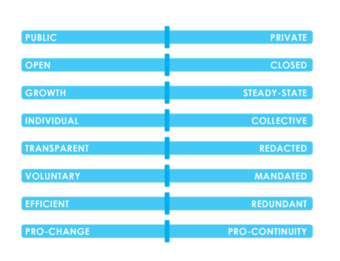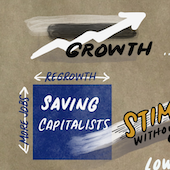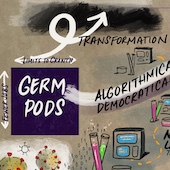Writing the Stories of the Future

After the Pandemic: Writing the Stories of the Future
How do we engage in the project of writing stories of a post-COVID-19 future?
With the support of Blue Shield of California Foundation and The James Irvine Foundation—IFTF wants to offer the public—communities, policymakers, civic and business organizations—a guide to creating new visions of the common future.
Think of this guide as a recipe with ingredients that you will need to imagine what is desirable, what you might want to avoid, and what you need to prepare for. What kinds of scenarios might it inspire?
Here’s a preview of the basic steps and some sketches of four alternative futures that the Institute for the Future will be using over the coming months to catalyze the insights of frontline workers, community voices, academic thought leaders, and policymakers.
A Basic Recipe for Visions of the Future
Step 1. Assess the Current Situation
What is revealed?
You can start to think about the future right now. Engage in conversations in your community, in your organization, within your family about what they’re seeing around them. Talk to people outside your daily circle and find out what life feels like for them at ground level—get at what we call “ground truth” for lots of different kinds of people. Everyone has a different view of the current situation, and those views fill in the details of a well-imagined story. What did you not know or think about before the crisis? What surprises you? What kinds dilemmas are suddenly laid bare?
Step 2. Look back to see forward
Discern larger patterns
Today’s health and economic crises are repeat performances of past crises, albeit in a very different context. We cannot think about the future without understanding these prior crises and the consistent patterns they’ve exhibited. What did we do in the past? What decisions did key players have to make? What can we learn from their successes and errors? History is not a rigid lesson, but it’s a prompt for our imagination. How will we turn an expanded awareness of the past into the ingredients for new stories of the future?
Step 3. Collect signals of the future
Detect novel responses to a novel virus
As important as the large patterns from the past are, the small signals all around us today point to what’s possible in the future. Signals are concrete events, data points, and developments from the present that give us hints of the future. Side by side with signals of disruption are signals of invention. What signals do you see around you today that give you hope or give you pause? What signals make you question commonly held assumptions? What signals suggest the beginning of a larger pattern that’s forming (Step 2)?
Step 4. Lay out a framework for choices
What values will make the future?
The patterns from the past and present and the signals from the future reveal choices that will mark our path. Do we self-isolate in a time of pandemic for collective well-being or do we find ourselves struggling with the choices—or lack of choices—about how much to self-isolate? Do we protect the immediate economy (in an attempt to save jobs, worker savings, and stock values in the short-term), or do we protect human lives (and thereby assure a vital workforce in the long-term)? These kinds of polar choices point to dilemmas that stem from competing values. Can we use these polar values to discover unimagined paths to travel the future.
For example, in the COVID-19 crisis, we might start by listing all the debates about how to respond. We can examine these debates to find a core set of values—polar values—that might guide our choices.
Step 5. Create your own future stories
What’s the path to the future YOU want most or the one you most fear?
Stories have beginnings, middles, and ends. Today, most of us are telling stories about how the COVID-19 pandemic started, how we’re coping with the crazy-hard challenges we face in a stay-home world and how this global catastrophe might end in three months or three years. But we can think of the future as three curves of global change.
Right now we are in the Response phase. Response is usually followed by a Reset—the time when we put the crisis into a larger perspective, when we assign it meaning, and rebuild stability. After reset comes Reinvention. What do we want to build? What choices do we need to make? Who needs to make these choices? What can I, my community, or my organization do to make our future story a reality? And how do these choices shape four archetypal futures of Growth, Constraint, Collapse, and Transformation?
Sketches of Four Futures
Here are sketches of initial visions of these four futures to get you started thinking about the alternatives...
GROWTH
Economic priorities
A "rush to reopen" leads to slow and unequal regrowth of the economy—with few rewards for the low-paid heroes of the pandemic response![]() See the full graphic.
See the full graphic.
COLLAPSE
Political divisions
Minimal mitigation leads to repeating viral spikes—exaggerating underlying divisions and splitting loyalties across and within states.![]() See the full graphic.
See the full graphic.
All illustrations by Anthony Weeks.
 CONSTRAINT
CONSTRAINT
Social sensibilities
Flattening the curve signals a willingness to sacrifice the economy for human solidarity—with universal basic income and assets.![]() See the full graphic.
See the full graphic.
TRANSFORMATION
Cultural hubs
Extensive contract tracing reveals hubs of disease and immunity—fomenting new cultural identities across the networked world.![]() See the full graphic.
See the full graphic.
Step 6. Share your story
What can we create together in a post-outbreak world?
We humans are always telling stories to ourselves as we sift backward through our memories and look forward to tomorrow. Storytelling is our human superpower. It’s how we make a shared reality—however fragile that reality might be—from our individual memories and our collective imagination.
The pathway to creating the post-pandemic future that we want is to harness the best of our storytelling to guide our public and private lives. We need to use our ability to recognize patterns and signals as well as our diverse frameworks and values to assemble communities that can collectively create stories that will lead to the kinds of futures that touch our hearts as much as our minds.
This is the promise of futures thinking in a time of pandemic—to unite our human hearts and minds on the long path forward.
LEARN MORE
CC BY-NC-SA 4.0, 2020
If you are interested in learning more about IFTF's work in Post-COVID19 scenarios, please contact:
Ayca Guralp | aguralp@iftf.org
If you'd like to learn more about IFTF Vantage partnerships, please contact:







